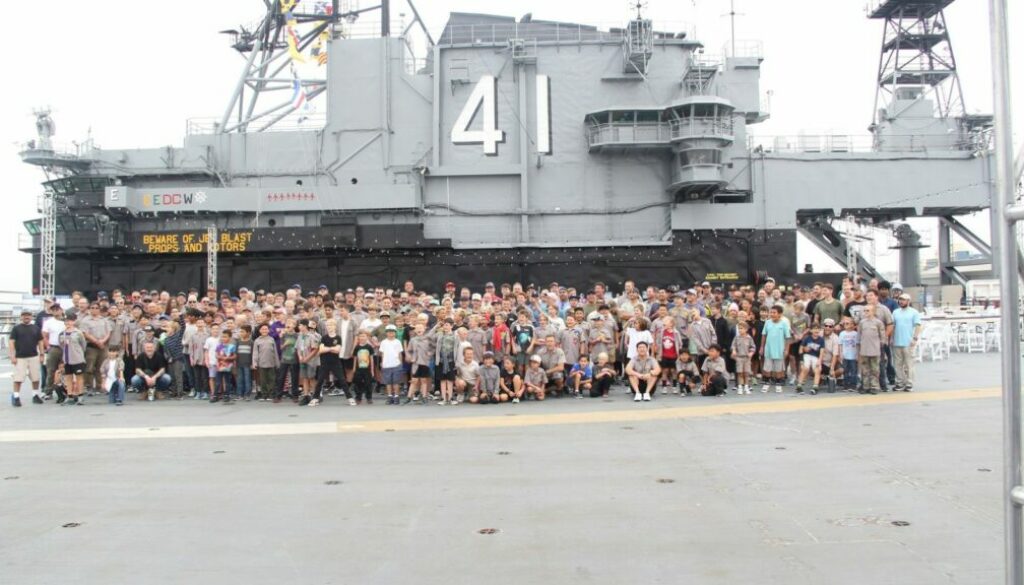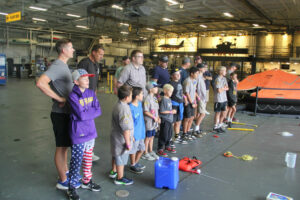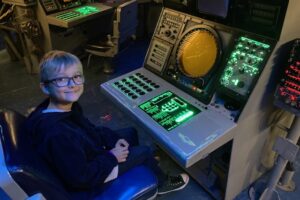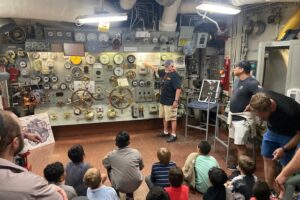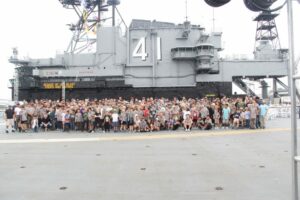Southern California Council Goes to Sea
Cadets, counselors, and parents boarded the USS Midway Museum in San Diego on September 19th, 2025, for an overnight adventure. Ten clubs, totaling over 250 boys and men from the Southern California Council, were represented.
The Midway Overnight Adventure is a structured event, with guided tours and behind-the-scenes excursions throughout the ship. After check-in on Friday evening, the “campers” boarded the ship and were separated into groups called squadrons. Each squadron name was selected from actual aircraft squadrons that had served on the USS Midway during its forty-seven years of active service. After being assigned to their squadron, Cadets and adults were guided to their berthing areas located toward the front (or bow) of the ship. Squadron members were berthed in actual U.S. Navy three-high beds called “racks”. After storing their gear, squadron members returned to the designated area on the ship’s hangar deck for further instructions before being dismissed to begin the adventure. Guided by members of the museum’s Education Department, each squadron followed a different schedule to visit eight areas of this massive floating museum.
On Friday evening, as the squadrons of Cadets and adults were guided from area to area, members of the Education Department or active duty military shared their experiences in engineering, aircraft operations (launching and recovery), navigation, security, and tactical communications during wartime.
During Friday evening and after each squadron had visited four areas, everyone enjoyed a brief free time on the Flight Deck. Cadets and parents were able to step back into history and relive the active service of rescue helicopters, cargo planes, and powerful fighter jets, climbing in and out of cockpits and cargo holds and taking in the sheer size and power of these fighting machines. As Friday evening ended, Council President Bill Mulder led the group in reciting our Cadet Landmarks, during which we declared our mutual commitment and love for Christ to each other and to the Midway staff. Then each squadron returned to its berthing area. Lights out promptly at 2200 (or 10 pm in civilian time) signaled a brief pause in the adventure. Revelle (or lights on) occurred at 0600 (or 6 am).
A full breakfast was provided by the museum’s kitchen staff at 0615, and regrouping was called at 0700 for a continuation of the adventure. Four more areas of the ship were scheduled for each squadron on Saturday morning.
These tours included the bridge where Midway sailors navigated the ship through the oceans; the flight deck where briefings on launching and recovering aircraft, as well as pre-electronic communication between ship personnel and pilots, were demonstrated. A visit to the Combat Information Center, or C.I.C., showed how equipment was used to find and interdict incoming enemy aircraft or ships, and to communicate with pilots in the cockpits of aircraft. Deep within the confines of the museum, squadrons visited one of four engine rooms, where massive steam generation machines produced enough power to support the ship’s movement and operations, including making fresh water. One engine room for each massive propeller. Also visited was Damage Control Central, or D.C.C., where the ship’s personnel responded to emergencies (fire, flooding, etc.). Squadrons also visited the living spaces of the United States Marine Corps detachment onboard the ship and received a briefing on the life and duties of a Marine on board the USS Midway.
Mid-morning on Saturday found our intrepid “Honorary Midway Museum crew members” back on the hangar deck for a final briefing and dismissal. The overnight adventure was ended, but with a promise to return in 2028 for a new generation of Southern California Cadets.
More about the USS Midway
The USS Midway was the longest-serving aircraft carrier in the 20th century. Named after the climactic Battle of Midway in June 1942, Midway was built in only 17 months but missed World War II by one week, when it was commissioned on Sept. 10, 1945. Midway was the first in a three-ship class of large carriers that featured an armored flight deck and a powerful air group of 120 planes.
Midway’s first combat deployment came in 1965 when it flew strikes against North Vietnam. Midway aircraft shot down three MiGs, including the first air kill of the war. However, 17 Midway aircraft were lost to enemy fire during this cruise. In 1966, Midway was decommissioned for a four-year overhaul. Over a chaotic two-day period during the fall of Saigon in April 1975, Midway was a floating base for large Air Force helicopters that evacuated more than 3,000 desperate refugees during Operation Frequent Wind.
As potential threats to the Arabian oil supply grew, and to relieve strain on U.S.-based carriers, Midway transferred to Yokosuka, Japan, making it the first American carrier homeported in a foreign country. In 1990, Midway deployed to the Persian Gulf in response to the Iraqi seizure of Kuwait. In the ensuing Operation Desert Storm, Midway served as the flagship for naval air forces in the Gulf and launched more than 3,000 combat missions with no losses. Its final mission was the evacuation of civilian personnel from Clark Air Force Base in the Philippines after the 20th century’s largest volcanic eruption of nearby Mount Pinatubo.
On April 11, 1992, the Midway was decommissioned in San Diego. It remained in the inactive ship fleet in Bremerton, Washington, until 2003, when it was donated to the 501(c)3 nonprofit San Diego Aircraft Carrier Museum. It opened as the USS Midway Museum in June 2004.
Special thanks to Counselor Craig for the story and photos!
If you have any questions or comments, please let the Corps office know at info@calvinistcadets.org.

